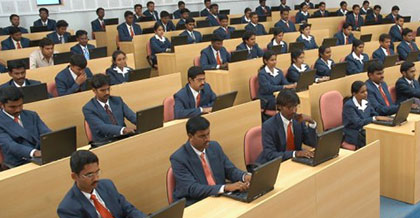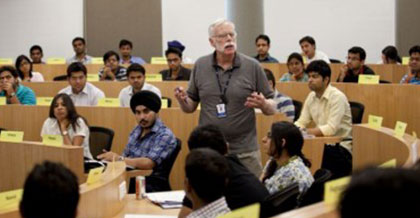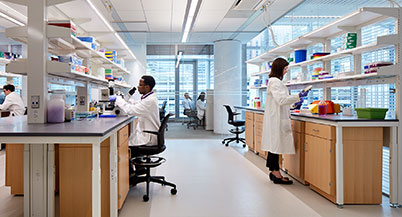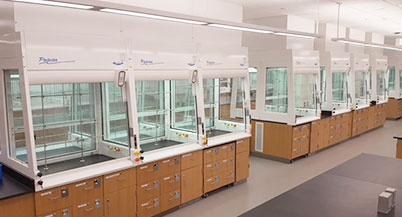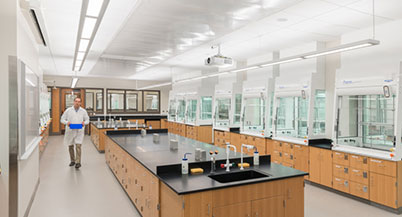through ICT-enabled
education.
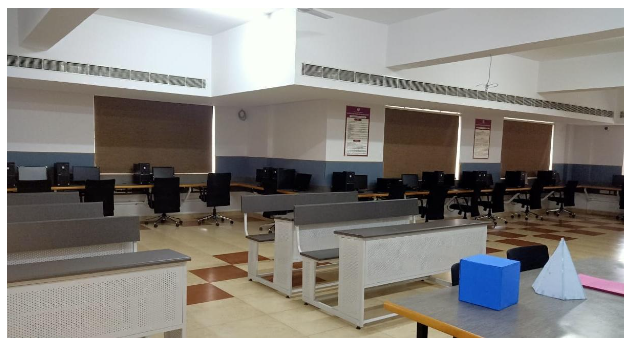
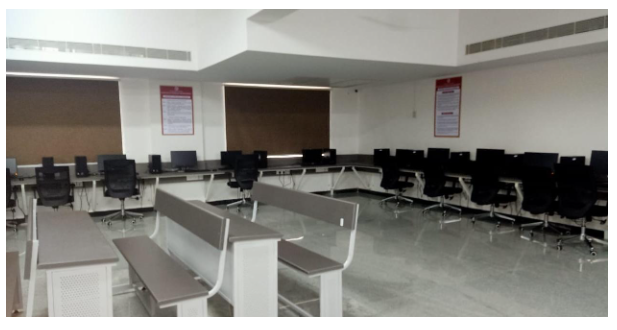
Computer-Aided Engineering Drawing (CAED) Lab is utilized by undergraduate students for software-aided drafting of 2D drawings. CAED is a technique where engineering drawings are produced with computer assistance, serving as a graphical means of representing a drawing or design.
Engineering drawing is the global graphic language used by engineers and technologists. It involves the graphic representation of physical objects and their relationships, conveyed through drawings using straight and curved lines to denote shape, size, and specifications. Understanding the theory of projection, dimensioning, and conventions related to working drawings is crucial for professional efficiency.
CAED involves preparing drawings of objects on a computer screen, supporting various types of drawings across engineering and science fields. Mechanical or aeronautical engineering focuses on machine component drawings and layouts, civil engineering involves building plans and layouts, and electrical engineering deals with power distribution system layouts. In all engineering fields, computers are utilized for drawing and drafting, with CAED offering enhanced graphics capabilities allowing designers to conceptualize ideas, modify designs easily, perform animations, make design calculations, and use colors, fonts, and other aesthetic features.
At RVITM, a licensed version of SolidWorks 2019 is used for drafting in the well-equipped CAED Lab, featuring sufficient systems and ICT tools in a centralized air-conditioned room
Machine Drawing and GD& T laboratory is used by UG students for software aided drafting of machine parts and assembly drawings. This involves study of conventions in drawings that are widely adopted in engineering practice.
Machine Drawing is representation of a machine component or machine by lines according to certain set rules. A machine drawing generally gives all the external and internal details of the machine component from which it can be manufactured. Machine part is presented through a number of orthographic views, so that the size and shape of the component is fully understood. Part drawings and Assembly drawings belong to machine drawing. Part drawing is a detailed drawing of a component to facilitate its manufacture. A drawing that shows the various parts of a machine in their correct working locations is an assembly drawing.
The machining symbols, tolerances, bill of material, etc. are specified on the drawing. GD&T, short for Geometric Dimensioning and Tolerancing is used to define the nominal geometry of parts and assemblies, to define the allowable variation in form and possible size of individual features, and to define the allowable variation between features. GD&T uses a symbolic language on engineering drawings and computer-generated three-dimensional solid models that explicitly describe nominal geometry and its allowable variation.
Machine drawing lab facilitates the application of software for drafting machine parts and assembly of machine parts, detailed sectional views. Licensed version of Solid works-2019 is used at RVITM for drafting. Lab is well equipped with sufficient systems and ICT tools in a centralized A/C room.
Introduction to python Laboratory is used by UG Students. Python is an interpreter, object-oriented, high-level programming language with dynamic semantics. Its high-level built-in data structures, combined with dynamic typing and dynamic binding, make it very attractive for Rapid Application Development, as well as for use as a scripting or glue language to connect existing components together. Python’s simple, easy to learn syntax emphasizes readability and therefore reduces the cost of program maintenance. Python supports modules and packages, which encourages program modularity and code reuse. The Python interpreter and the extensive standard library are available in source or binary form without charge for all major platforms, and can be freely distributed.
Often, programmers fall in love with Python because of the increased productivity it provides. Since there is no compilation step, the edit-test-debug cycle is incredibly fast. Debugging Python programs is easy: a bug or bad input will never cause a segmentation fault. Instead, when the interpreter discovers an error, it raises an exception. When the program doesn’t catch the exception, the interpreter prints a stack trace. A source level debugger allows inspection of local and global variables, evaluation of arbitrary expressions, setting breakpoints, stepping through the code a line at a time, and so on. The debugger is written in Python itself, testifying to Python’s introspective power. On the other hand, often the quickest way to debug a program is to add a few print statements to the source: the fast edit-test-debug cycle makes this simple approach very effective.
The Lab is well equipped with 20 number of high-performance computers. Software packages such as having IDLE (short for Integrated Development and Learning Environment) is an integrated development environment for Python, which has been bundled with the default implementation of the language campus-wide it is free license available from python website, and the same has been installed in the system.
The Design Laboratory contributes to educate the undergraduate student as well as in the research areas in the field of Mechanical Design. The mission of Design lab is innovative mechanical component design, improve design quality, shorten design time, and enhance design education. This lab experiments validates the concepts of kinematic and dynamic theories of machine components under motion condition. Students can be able to validate and extend the theoretical knowledge into practical machine applications. The structural analysis laboratory section has been designed to facilitate the practical study of structural response of basic structural elements, namely, the beam, column, rigid and pin jointed frames.
The Design Lab is containing 8 Equipment to conduction 10 experiments with highly standard. Experiment in the Design lab students can be able to Find the stiffness and critical damping of the system. Calculate the damping coefficient, logarithmic decrement, damping ratio, damping frequency and natural frequency of the system and Learn the effect of damping in forced vibration of a single degree of freedom due to forces. Students can able to get the knowledge on different types speed governors and strain gauges. By conducting Polariscope experiments for transparent materials students can understand the photo elastic principle is particularly suited for the analysis of stress distribution in flat models.
Computer Integrated Manufacturing (CIM) laboratory is used by UG Students, in this laboratory the students learn the fundamentals of numerical control (NC) technology, programming of computer numerical control (CNC) machines in NC codes using CAM systems. Students also gain experience in NC postprocessors and distributed numerical control, operation of CNC lathe and milling machines, and programming and machining complex engineering parts. CIM technology involves computer systems that plan, manage, and control the manufacturing operations through computer interface with the plant’s production resources. One of the most important areas of CIM is numerical control (NC). This is the technique of using programmed instructions to control a machine tool, which cuts, mills, grinds, punches or turns raw stock into a finished part. Another significant CIM function is in the programming of robots. Process planning is also a target of computer automation.
Artificial Intelligence and Machine Learning Laboratory – 18CSL76 (VTU AIML Lab) covers the different algorithms such as A* Search, A** Search, Find-S algorithms, Candidate elimination algorithm, Decision tree (ID3) algorithm, Artificial Neural Networks, Backpropagation Algorithm, Naïve Bayes classifier for text classification, Bayesian Belief Network, k-Means, and EM clustering Algorithm, k-Nearest Neighbour Algorithm (KNN), Locally Weighted Regression Algorithm..
Computer Networks lab is prescribed for UG students from the perspective of how the information is transferred from source entity to destination entity through different layers in the networks. This lab gives practical exposure towards implementing various routing algorithm in a network and understanding the networking techniques that take place in computer.
Programming is done using NS-2 simulator. NS2 is an open-source object oriented, discrete, event-driven network simulator written in C++ and Tool Command Language (Tcl) with Object Oriented extensions (OTcl). It implements network protocols for network simulations. NS-2 includes a tool for viewing the simulation results, called network animator (NAM). NAM is a Tool Command Language/Toolkit (Tcl/Tk) based animation tool for viewing network simulation results and real-world packet trace data.
In general, NS2 provides users with a way of specifying different network protocols and simulating their corresponding behaviors.Various traffic generators are present for generating traffic at source nodes in wired network simulation, for example, CBR, VBR, and Exponential etc. NAM stands for Network Ani Mator window is a visualization tool used in NS2 to provide outputs on a window screen which shows the network scenarios like at what time and at how much rate data packets starts dropping etc.
The lab is well lab is well equipped with 20 number of high performance computers. Software packages such as NS-2 simulator and Code blocks software also Digital Storage Oscilloscope for carrying out various advanced experiments.
Artificial Intelligence and Machine Learning Laboratory – 18CSL76 (VTU AIML Lab) covers the different algorithms such as A* Search, A** Search, Find-S algorithms, Candidate elimination algorithm, Decision tree (ID3) algorithm, Artificial Neural Networks, Backpropagation Algorithm, Naïve Bayes classifier for text classification, Bayesian Belief Network, k-Means, and EM clustering Algorithm, k-Nearest Neighbour Algorithm (KNN), Locally Weighted Regression Algorithm.

“The vision of our Trust is to impart quality education at reasonable cost in all core disciplines and develop global leaders who are confident, ethical, smart, and engaged in all areas of life.
To fulfill the mission of our founder ‘Imparting Quality Education to all Strata of the Society’, the Trust has established several educational institutions. We celebrate youth and transform them into adults with a sense of social responsibility, humane values, and concern for the environment.
Our endeavor is to ensure that our students gain academic excellence along with required soft skills to become excellent scientists, technologists, thinkers, leaders, and better human beings.
Today, RV institutions are a household name in academic, industrial, and corporate circles. The last eight decades have seen this Trust rise from strength to strength through the establishment of a number of institutions.
With state-of-the-art infrastructure, tech-savvy ambiance, and the latest tools, we equip our students to stride with competitive fervor. We also empower them with job-oriented courses, career-coun

Rashtreeya Vidyalaya (RV) institutions are at the forefront among providers of quality education in the state of Karnataka. In line with our mission statement ‘Excellence in Education with Societal Commitment’, our institutions have been providing quality education to all sections of society for the past eight decades.
Our institutions have been providing opportunities, especially to students who are differently-abled and/or hail from an economically weaker background, to fulfill their dreams. With more than 23 institutions under the umbrella of Rashtreeya Sikshana Samithi Trust, we are present in almost all spheres of academics. I am proud to say that our institutions have made a niche for themselves for their academic excellence.
We encourage our students to go beyond the regular curriculum to sharpen their soft skills and foster innovation through various curricular and co-curricular activities. The backbone of any educational institution is its faculty, and our faculty members are abreast in their domain knowledge and continuously strive for R&D and innovation.
We ensure that all our institutions are equipped with the best infrastructure and laboratories to foster an academic and innovative atmosphere.
Over the years our goals have not just been to provide quality education to our students, but also teach them to uphold the values and traditions of our motherland. It is our responsibility to train and groom the future citizens of our country.
Our dream and commitment is to see each and every one of our students become a success story.
Lab Name / Code: Microcontroller and Embedded Systems Lab / 18CSL48 – IV SEMESTER (ISE)
The importance of Microcontroller and Embedded Systems is well known in various engineering fields, such as Computer Science, Information Science, Electronics, and Electrical engineering. A microcontroller is an independent system with a processor, memory, and General Purpose Input Output (GPIO) pins that can be used as an embedded system. Most of the microcontrollers in use today are embedded in other machinery, such as automobiles, smartphones, home appliances, and peripherals for computer systems.
In this lab, students are exposed to:
Mechanical Measurements and Metrology (MMM) laboratory is used by UG Students for measurements of various dimensions and tolerances of many components, and the procedures taught in the lectures are put into practice and expanded through practical trainings. Engineering metrology deals with the applications of measurement science in manufacturing processes. It provides a means of assessing the suitability of measuring instruments, their calibration, and the quality control of manufactured components. An organization should strive towards a zero-defect regime in order to survive in a highly competitive market. Ensuring this aspect of manufacturing is the responsibility of a quality control engineer, who must be completely familiar with the basics of measurement, standards and systems of measurement, tolerances, measuring instruments, and their limitations.
The MMM lab is equipped with a number of sophisticated equipment’s, for calibration, and for dimension measurement experiments to measure angular, linear measurements and tolerances. Furthermore, calibration of micrometre, slide callipers and other similar gauges. Several optical instruments for measuring linear and angular dimensions. Calibration of pressure, temperature, torque, stain gauge and load cells. Additionally, thread measurement by optical means and compound micrometre with 1, 2, 3 wire methods. Mitutoyo Instrument for measurement of surface roughness of various components.
Scope of Metrology
Mechanical measurements and Metrology Lab has various measurement and calibration equipment’s. The major measuring instruments available are Profile projector, Tool maker’s microscope, Floating carriage micrometer, Autocollimator, etc. The major calibration equipment’s are Sine bars with slip gauges, Thermocouple, Sine center, Strain gauge, Pressure gauge, etc.
Heat Transfer laboratory provides fundamental and industrial knowledge about modes of heat transfer, like conduction, convection and radiation, and their applications. Heat Transfer Lab consists of the following equipment’s such as, natural and forced convention heat transfer set-ups, conduction and radiation heat transfer equipment’s etc. This lab also consisting refrigeration and air conditioning basic experimental set up to explain the fundamental concepts of air conditioning.
This laboratory will provide students with the necessary skills to conduct experiments on conduction and convection of heat; collect data, perform analysis and interpret results to draw valid conclusions through standard test procedures. This lab also helps to understand the various thermal properties and performance of radiation heat transfer, heat exchanger, vapor compression refrigerator and air conditioner.
Foundry, Forging and Welding lab, is a part of Mechanical Engineering and it is equipped with state of the art lab/research facilities viz. molten material preparation, sand testing equipment, various casting, forging equipment’s and welding machines etc. Here, the students will be working on various processes involved in casting and forging operations and learn the art of producing forged models like square rod, square bolt, hexagonal bolt etc. students will learn to make mould cavity with use for patterns namely single piece pattern and split piece pattern for casting using moulding sand. Then, students will be testing the strength of the moulding sand such as tensile strength, compressive strength, mould hardness, core hardness, permeability test, moisture content test etc. In this lab students will also be trained to do arc welding operations making different joints such as lap joint, butt joint, corner joint etc. Lab is provided with proper ventilation, space and sufficient lighting.
Fluid mechanics is that the branch of engineering. Science which deals with the behavior of the fluids at rest as well as in motion. In general, the scope of fluid mechanics is very wide which includes the study of all gases and liquids. Fluid mechanics deals with the analysis and methods to solve many engineering problems involving liquid flow, such as flow through pipes or channels, storage dams, pumps and water turbines, hydraulically operated machines such as lift, crane, press etc. Hence it is essential for the engineering students of Civil, Mechanical, and allied branches of engineering to understand the theoretical and practical aspects of fluid mechanics
This laboratory is run in conjunction with the theory course (Fluid Mechanics and Machinery Lab). It is an introductory course where flow behavior, fluid forces and analysis tools are introduced. The goals of the experiments include understand the minor and major losses in flow though pipe and impact of jet experiment include determination of forces generated when fluid flow takes place over a solid object. The venturi meter, orificimeter and notch experiments will help in understanding the flow rate of fluids. The Pelton, Francis and Kaplan will demonstrate the working and analysis of hydraulic turbines. Similarly, the pump, air blower and compressor experimental set up gives information of working hydraulic machines under different conditions. This lab focuses on giving the user idea about the practical behavior of flow measuring devices and machines before performing operations on a real system.
Energy Conversion (EC) laboratory provides the working operations of Internal Combustion (IC) Engines (Compression Ignition (CI) Engines and Spark Ignition (SI) Engines) and its applications. The EC lab consists of the following equipment such as Four Stroke (4S) Multi-Cylinder Petrol Engine (Morse Test), 4S Single Cylinder Petrol Engine with Variable Compression Ratio (VCR), 2S Single Cylinder Petrol Engine, 4S Single Cylinder Diesel Engine, Cut Model of 4S Diesel Engine, Petrol Engine, Torsional Viscometer, Redwood Viscometer, Bomb Calorimeter, Boy’s Gas Calorimeter etc., This laboratory also consisting of emission test rig to calibrate the emission parameters during the engine operations.
At the end of the laboratory experiments, the students will be able to know about all the experiments of EC Laboratory and provide the practical knowledge on I.C Engines performance and emissions measurements and calorific value & viscosity of various sample oils.
Computer Aided Modelling and Analysis Laboratory is used by UG Students. The ANSYS program has many finite element analysis capabilities, ranging from a simple, linear, static analysis to a complex, nonlinear, transient dynamic analysis. The analysis guide manuals in the ANSYS documentation set describe specific procedures for performing analyses for different engineering disciplines.
A typical ANSYS analysis has three distinct steps:
The finite element method is perhaps the most popular numerical technique for solving engineering problems. The finite element method is generally enough to handle any complex shape or geometry, any material properties, any boundary conditions and any loading conditions. In addition, it is an efficient design tool by which designer can perform parametric design studies by considering various design cases (different shapes, materials, loads etc.), analyses them and can choose the optimum design.
The Lab is well equipped with 20 number of high performance computers. Software packages such as ANSYS having campus-wide license available from CADFEM India (P) Ltd., and the same has been installed in the system.
This communication Lab provides the necessary hardware and software resources to the undergraduate students of Electronics and Communication Engineering for enhancing their skills in communication field.
In this laboratory, UG students are trained for constructing the circuits for analog and digital modulations. The concepts of all type of modulation and demodulation, and recent communication techniques are demonstrated using available hardware and software tools.
This course familiarizes the students with basic analog communication systems with experiments so that the students appreciate the knowledge gained from the theory course by giving them deep knowledge about the principles and techniques of modern communication systems. It includes knowledge in various methods of analog communication including amplitude modulation (AM) and frequency modulation (FM) with detailed analysis on signal flow and it’s nature.
This lab also focuses on understanding the fundamental concepts of signal flow in a digital communication system. Detailed analysis of TDM, Pulse modulations, digital modulation techniques, sampling and reconstructions are done.
Theory in the classroom is translated directly into practice with the help of MATLAB software. The lab is well equipped with 20 number of high
performance computers and AM/FM Modulation & Demodulation Trainer Kits, FSK/PSK Mod & Demodulation Trainer Kits, TDM Mod & Demodulation Trainer Kits, Sampling & Reconstruction Trainer Kits, X-Band Microwave Test Benches, S-Band Microstrip Component Study and Antenna Trainer Kits, and Digital Storage Oscilloscope to carryout advanced experiments.
Embedded systems are used everywhere – starting from simple everyday appliances to complex multimedia and biomedical equipment’s.
The embedded system lab is designed for facilitating embedded software and hardware education, including embedded C programming, embedded system design, advanced digital design, and real-time application.
The ARM Cortex-M3 is a general purpose 32-bit microprocessor, which offers high performance and very low power consumption. The Cortex-M3 offers many new features, including a Thumb-2 instruction set, low interrupt latency, hardware divide, interruptible / continuable multiple load and store instructions, automatic state save and restore for interrupts, tightly integrated interrupt controller with Wakeup Interrupt Controller, and multiple core buses capable of simultaneous accesses.
The lab is well equipped with 20 number of high performance computers with ARM Cortex M3 Kit, DC Motor, Stepper Motor and and Digital Storage Oscilloscope to carryout advanced experiments.
Verilog is a Hardware Description Language; a textual format for describing electronic circuits and systems. Applied to electronic design, Verilog is intended to be used for verification through simulation, for timing analysis, for test analysis (testability analysis and fault grading) and for logic synthesis.
In this lab simple circuits will be designed by programming the field-programmable gate array (FPGA). At the end of the lab, students will understand the advantages of such an approach over using discrete components should be gained.
Programming can be done using Xilinx ISE . Download the programs on a FPGA/CPLD boards such as Spartan 6 and performance testing may be done using 32 channel pattern generator and logic analyzer apart from verification by simulation with tools such as Xilinx.
The lab is well equipped with 20 number of high performance computers, Spartan FPGA Kits, USB Dongle and Digital Storage Oscilloscope to carryout advanced experiments.
Digital Signal Processing Laboratory is used by UG Students for the theoretical contents taught in the lectures are put into practice and deepened through practical trainings. Digital Signal processing techniques improve signal quality or extract important information by removing unwanted part of the signal or processing the signal to understand the signal properties. Digital Signal Processing accounts for a substantial proportion of the world market for electronic devices, and therefore, the leading electronics manufacturers are using DSP technology.
The lab is well equipped with 20 number of high performance computers. Software packages such as MATLAB with Simulink having Campus-wide license available from Mathworks and Code composer studio are installed in the systems. The lab has Texas Instruments TMS320C6748 DSP Starter Kit with XDS100 Emulator DSP kits along with Digital Storage Oscilloscope for carrying out various advanced experiments.
Know the components and structure of mobile application development frameworks for Android and windows OS-based mobiles.
File Structures Lab provides facility to the students to Organize the Data in Secondary Storage devices in such a way that minimize the access time and the storage space. Students can understand and practice how to find the data that matches some search criteria or reading through the data in some particular order.
File Structures Lab enables the students to
Based on the ability of the students and recommendations of the mentor, a single discipline or a multidisciplinary Mini- project can be assigned to an individual student or to a group having not more than 4 students and this Mini-Project work will be evaluated as per VTU guidelines.
The practise of reviewing and validating that a software product or application accomplishes what it is designed to do is known as software testing. The advantages of testing include the prevention of bugs, the reduction of development expenses, and the improvement of performance. In this lab students learn to:
DBMS Lab provide the student with strong foundation in database concepts, technology and provide with extensive practice to the students and groom them into well-informed database application developers. Working on existing database systems, designing of database, creating relational database, analysis of table design.
Computer networking focuses on explaining how the Internet works, ranging from how bits are modulated on wired and wireless in application-level protocols.
Know the components and structure of mobile application development frameworks for Android and windows OS-based mobiles.
Computer graphics is related to all aspects of producing images using a computer. It focuses on the mathematical and computational foundations of image generation and processing rather than purely aesthetic issues.
The Software Systems Laboratory (SSL) pursues basic research in all aspects of the design, implementation, evaluation, and verification of software systems. We conduct research with systems at all scales, from handheld devices to cloud computing data centers. We take an experimental systems approach in building real systems to investigate new research ideas. Particular areas of interest include cloud computing, distributed systems, formal methods, mobile computing, operating systems, privacy, security, and software engineering.
DBMS Lab provide the student with strong foundation in database concepts, technology and provide with extensive practice to the students and groom them into well-informed database application developers. Working on existing database systems, designing of database, creating relational database, analysis of table design.
Computer networking focuses on explaining how the Internet works, ranging from how bits are modulated on wired and wireless in application-level protocols.
To make students to Implement data link layer and transport layer protocols.
Lab Name / Code: Digital System Design Laboratory (18ECL38) – III SEMESTER (ECE)
Digital System Design Laboratory consists of major equipment like Digital IC Trainer Kit, Digital Signal Generator (DSO), Signal Generator, testing kits, and other required accessories. This laboratory is designed for III semester undergraduate students who use discrete components to test and verify logic gates and implement experiments like comparators, flip-flops, shift registers, adders, etc. Open-source simulation tools are used analyse serial adders and binary multipliers.
Lab Name / Code: Metrology and Mechanical Measurements Lab (18MEL37B) – III SEMESTER (ME)
Metrology and Mechanical Measurements Lab consists of Pressure Cell, Toolmakers Microscope, Profile Projector, Autocollimator, Lathe Tool Dynamometer, Drill Tool Dynamometer, Floating Carriage Micrometer, Gear Tooth Micrometer, Surface Roughness Tester, and Slip Gauges.
Theoretical concepts will be illustrated for students through experiments, the use of various measuring tools, and techniques. In addition, calibration techniques of various measuring devices will also be taught.
Lab Name / Code: Material Testing lab 18MEL37A – III SEMESTER (ME)
Material Testing Laboratory is designed to help students practically understand the characteristics and behaviors of various materials, such as metals, ceramics, plastics, and more. All students will learn to prepare samples and characterise the materials based on their performance ( microstructure, the volume of a fraction of phases, and grain size). In addition, students will learn material failure modes and the different loads causing failure.
The important equipment in the lab includes a Metallurgical Microscope, Brinell Hardness Tester, Vickers Hardness Tester, Ultrasonic Flaw Detector, Electronic Universal Testing Machine, Torsion Testing Machine, Izod-charpy Impact Testing Machine, Wear Testing Machine, and Fatigue Testing Machine. The computerised UTM helps students to plot the graph digitally during the experiment.
Lab Name / Code: Data Structures Lab / 18CSL38 – III SEMESTER (ISE)
Data Structures is a technique of organising, managing, and storing data for efficient usage and modification. It is a fast and cost-effective solution. This laboratory course enables students to get practical experience in design, development, implementation, analysis, and evaluation/testing of the following:
Analog Circuits Laboratory
Lab Name / Code: Analog Circuits Laboratory (18ECL48) (IV SEMESTER (ECE)
The focus of the Analog Circuits Laboratory at the ECE department is to expose the students of IV semester UG to electronic devices such as BJT, FET, and OPAMPS. This laboratory has DSO, Signal Generator, DC Power Supply, and Digital Meters as major equipment. Our students will be designing analog circuits using BJT, FET, and OPAMPS to evaluate their performance characteristics. They will also simulate and analyse analog circuits for different electronic applications.
Lab Name / Code: Analog and Digital Electronics Lab / 18CSL37 – III SEMESTER (ISE)
Analog and Digital Electronics is one of the fundamental courses of Computer Science and other engineering streams. Analog circuits process signals with continuous variation of voltage. This laboratory course enables students to get practical experience in design, assembly, and evaluation/testing of the following:
Lab Name / Code: Foundry, Forging and Welding lab (18MEL38B) – IV SEMESTER (ME)
The focus of Foundry, Forging, and Welding Lab is to expose the students of IV semester UG to Universal Sand Testing Machine, Sieve Analyser, Permeability Tester, Clay Content Tester, Sand Rammer, Moisture Content Tester, Core Hardness Tester, Welding Machine, Electric Melting Furnace, and Forging Furnace.
Students will be provided with training to enhance their practical skills in welding, forging, and hand molding. All the instructions will be practically demonstrated with necessary precautions during casting, hot working, and welding operations.
Lab Name / Code: Workshop and Machine Shop Practice (Consists of fitting and machining) (18MEL38A) – IV SEMESTER (ME)
Students use fitting tools to perform fitting operations and they will be provided insight into different machine tools, accessories, and attachments. Students will be trained with fitting and machining operations to enrich their practical skills.
Machine shop laboratory will have major equipment such as Lathes, Shaping Machine, Universal Milling Machine, Bench Grinder, Power Hack Saw, and Radial Drilling Machine.
Lab Name / Code: Electronic Devices and Instrumentation Laboratory (18ECL37) – III SEMESTER (ECE)
Electronic Devices and Instrumentation Laboratory is designed for III semester UG students. The major laboratory equipment includes Digital Signal Generator (DSO), Signal Generator, Wheatstone, and Kelvin Bridge, DC Power Supply, etc. The students will be able to understand and test the characteristics of various electronic devices like diodes, rectifiers, LDR, and SCR. They will use simulation software for the implementation and characterization of electronic circuits and devices.
Lab Name / Code: Design and Analysis of Algorithms Lab / 18CSL47 – IV SEMESTER (CSE)
Algorithm analysis is an important part of a broader computational complexity theory, which provides theoretical estimates for the resources needed by any algorithm which solves a given computational problem. These estimates provide an insight into reasonable directions of the search for efficient algorithms.
This course will enable students to:
Lab Name / Code: Microcontroller Laboratory (18ECL47) – IV SEMESTER (ECE)
Microcontroller Laboratory in the ECE department is designed to cater to the curriculum of IV semester UG students. The laboratory mainly consists of Programmable Evaluation Board, Dual DAC Interface, Elevator Interface, Multiplexed Display and Key Pad, Stepper Motor and DC Motor Interface as major equipment. The students will be executing the assembly language programme in 8051 and will also interface various input and output devices for different applications like serial LCD Display, Stepper Motor Control, Serial Data Transfer, etc.
Lab Name / Code: Design and Analysis of Algorithms Lab / 18CSL47 – IV SEMESTER (ISE)
Algorithm analysis is an important part of a broader computational complexity theory, which provides theoretical estimates for the resources needed by any algorithm which solves a given computational problem. These estimates provide an insight into reasonable directions of the search for efficient algorithms.
This course will enable students to:
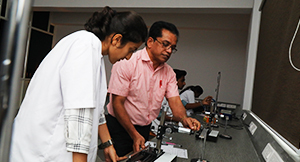
RV Institute of Technology and Management (RVITM), one of the most ambitious projects of RSST began in 2016 and I have been a part of it since then. In fact, my association with the RV group of institutions dates back to 1986.
RV Institute of Technology and Management (RVITM), one of the most ambitious projects of RSST began in 2016 and I have been a part of it since then. In fact, my association with the RV group of institutions dates back to 1986.
RV Institute of Technology and Management (RVITM), one of the most ambitious projects of RSST began in 2016 and I have been a part of it since then. In fact, my association with the RV group of institutions dates back to 1986.
RV Institute of Technology and Management (RVITM), one of the most ambitious projects of RSST began in 2016 and I have been a part of it since then. In fact, my association with the RV group of institutions dates back to 1986.
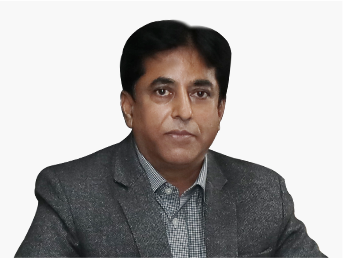
RV Institute of Technology and Management (RVITM), one of the most ambitious projects of RSST began in 2016 and I have been a part of it since then. In fact, my association with the RV group of institutions dates back to 1986.
From a preliminary concept plan to a full-fledged college, I have seen RVITM bloom into an educational hub for passionate engineers across the country. And I feel privileged that my 30+ years of experience was leveraged in building this institution.
Today, RVITM has a talented faculty, who come with vast industry experience. And in view of the ICT-enabled teaching, our faculty is well-trained to handle the hands-on curriculum.
The softcopy of the complete course material is made available for all the students from the very beginning of the academic year. Also, we employ ICT tools in conducting our lectures, online quizzes, and tests. All classrooms have smartboards, lecture video recording facilities, and more. All of our lectures are recorded so that our students can listen to them at their own convenience.
Moreover, our serene campus is equipped with state-of-art laboratories, a placement office, a rich library, a reading room, seminar and conference halls, a sports club, first aid room, stationery store, and much more.
I believe that with all the best-in-class facilities, a dedicated teaching faculty, and state-of-art infrastructure, RVITM has the potential to be one of the most looked-up institutions for technical education in the country.
RV Institute of Technology and Management (RVITM), one of the most ambitious projects of RSST began in 2016 and I have been a part of it since then. In fact, my association with the RV group of institutions dates back to 1986.
RV Institute of Technology and Management (RVITM), one of the most ambitious projects of RSST began in 2016 and I have been a part of it since then. In fact, my association with the RV group of institutions dates back to 1986.
